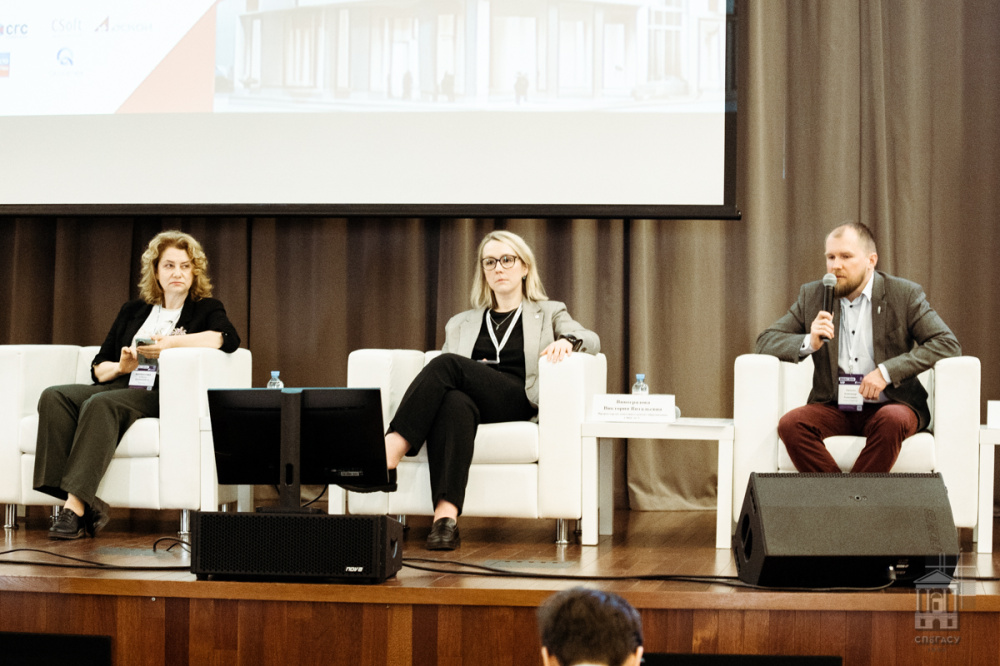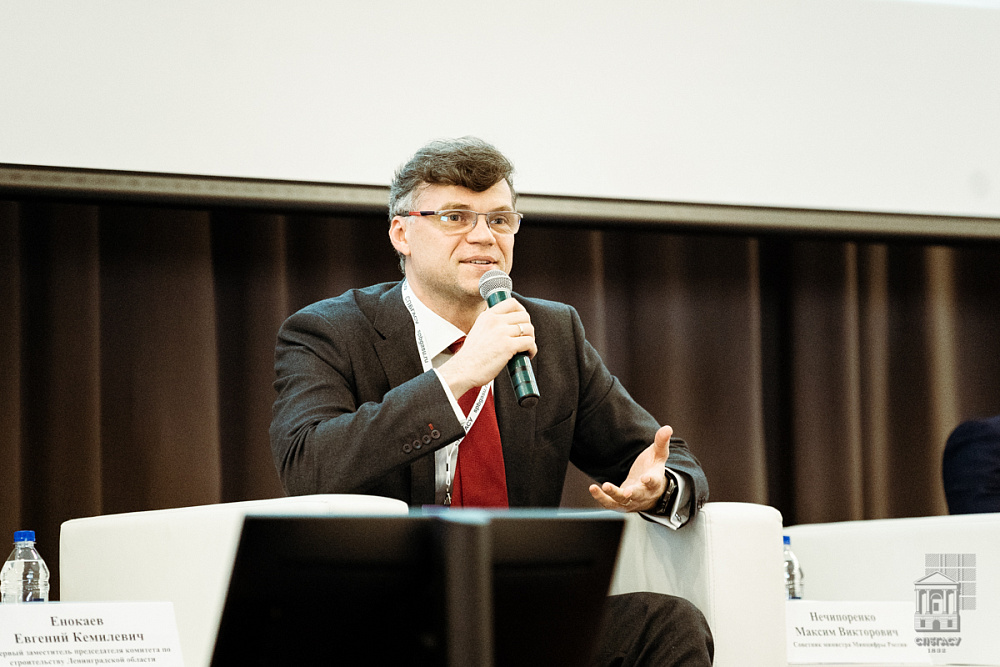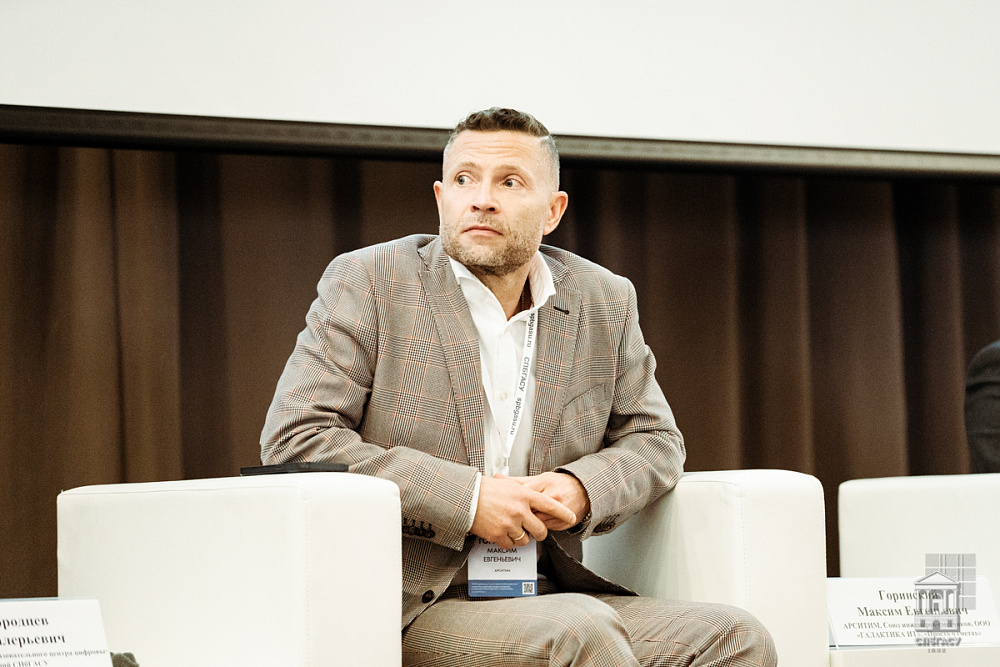 Elena Kolosova, Viktoria Vinogradova and Aleksandr Ladygin
Elena Kolosova, Viktoria Vinogradova and Aleksandr Ladygin
The speakers of the BIMAC plenary session considered information modeling technologies (TIM) as a driving force for the integration of technologies, data, organizations and specialists. The moderators - General Director of Roseko-Stroyproekt Aleksandr Ladygin and Deputy Director of the SPbGASU Center for Digital Competence Denis Nizhegorodtsev noted: this topic is in the center of attention of all industry participants and specialized educational institutions, since everyone understands that this integration is necessary.
TIM as a near certainty
Advisor to the Minister of Digital Development, Communications and Mass Media of Russia, Deputy General Director of Renga Software (part of the company "ASCON") Maksim Nechiporenko recalled that the company, together with the market, have studied and automated everyday tasks for a quarter of a century and assessed the prospects in the construction sector. Therefore, it was ready for digitalization.
"From process automation, software creation to mechanisms that allowed integrating three-dimensional models, we approached the development of new products, so there was no doubt about the need for TIM. After the departure of foreign vendors, there were quite a lot of companies developing various software on the domestic market. We had a whole set of products with different functionality, implementation methods, so we began to study with partners how these products could interact with each other, how the customer would use them. But in practice, nuances still arise, and our task is to adapt them at customer enterprises taking into account their activities, planned deadlines for the implementation of production work, assigned resources, and existing competencies. We agree with developers on a more complex technological meaning and simpler interaction for users," noted Maksim Nechiporenko.
Live data is the key to success on construction sites
Elena Kolosova, Development Director of K4 LLC, noted that the entire construction process could be stopped due to documentation that was not prepared on time and was late for the construction site, or materials were not delivered on time. Due to such nuances, downtime occurs, and as a result, maintaining one worker at the construction site costs the company up to a million rubles per month. “TIM will be widely used when builders evaluate its advantages, efficiency, and want to implement it. While they are hesitating, designers are torn apart, processes are delayed, and the builders themselves do not receive value from the implementation. As a result, the situation is as follows: the data has not reached the construction site, and the team is idle. How to avoid this? Provide the construction site with complete data. The designer can give the builder almost all the information. Therefore, the designer can either organize the construction or kill it. In order to prevent the latter, he must provide the construction in advance. With the highest organization of processes, this requires at least a quarter of the year. The use of TIM can help minimize such losses.
Designing "on the fly" leads to failure. What prevents us from building a data system in which everyone will use the same information collected from different sources? We need to encode information so as not to re-enter data, rewriting it from documents sent in different formats, for example, PDF. As a result, documentation takes more time than production work. All these problems are solved by an information model, in which all participants in the construction process see the information in real time. Models do not operate with words, so the encoding system is important here," said Elena Kolosova.
Reference books, classification, identification
Kira Besprozvannaya, Head of the BIM Department at ASCON-North-West LLC and a graduate of St Petersburg State University of Architecture and Civil Engineering, agreed that TIM is, first and foremost, information, and for it to bring value, the entire process needs to be automated: competencies, interaction with other information systems, libraries, and model export settings are important.
"It is important to implement technologies not by obligation, but by choice. We begin our work with the customer by finding out what software products they work with, with whom and how they exchange data, we are interested in the scenario and goals of implementation, we study the standards of their activities. Then the technologies are adapted, and the implementation is effective. Then we provide training and support to the customer. This approach leads us to the creation of successful cases," said Kira Besprozvannaya.
Kirill Voytyuk, Development Director of IBIM LLC, confirmed that when implementing information systems, it is necessary to bring reference books to a common form, and the company is doing this successfully.
"TIM should be implemented to solve specific problems. Today, there are planning tools, but the construction schedule printed on wallpaper still lives on. It's strange. We work out the model with clients before construction, conduct scenario analysis, thus we conduct optimization, which, in turn, can be absolutely different, and its effectiveness is confirmed in practice. We have a product that allows you to check for all collisions," said Kirill Voytyuk.
Technical expert of Tangle LLC Alla Zemlyanskaya reminded that data is a connecting component of processes, people, regulations, rules and technologies themselves. But it is necessary to differentiate between the concept of data and information.
"Data is a set of facts, observations, numbers, presented in raw form. Information is the processed structured data that is useful. To identify data, you need to designate its specific characteristics and purpose. Automation is needed to process it faster. We do this for specific requests for specific specialists, so that the data is a working tool. Throughout their life cycle, they must be handled correctly, so we are working on integration," Alla Zemlyanskaya clarified.
Estimators advocate for innovation
The President of the Association for the Development of Digital Solutions in the Sphere of Cost Engineering, Pricing and Information Modeling Technologies, Vice-President of the Union of Estimating Engineers for Regional Development, Director of Galaktika IT LLC, Editor-in-Chief of the Telegram channel “Just about estimates” Maksim Gorinsky clarified that today in our country there are three areas of the industry: the Register of Requirements (technical regulation, machine-readable and machine-understandable formats, parametric standardization), digitalization (classification, automation, XML, CIM/TIM) and pricing (resource method, maximum starting price of contract and contract estimate).
"Only the interest of experts and banks in this can spur the transition to TIM, since we are talking about transparency and reliable volumes. The more companies start implementing TIM, the more feedback there will be and the faster these digital products will develop. Today, the regulator pays great attention to the quality of design and reducing the time it takes to get to the construction site, but for some reason it turns out that they also want to do all this cheaply. That is, to simultaneously fulfill all three conditions: high quality, fast, inexpensive. Obviously, this is impossible, so we still need to remember the third component - finances. It is the automation of the process that helps in decision-making and the way to reduce labor costs. If an estimator picks up standards with his eyes from morning to night or recalculates a project in a rush on the eve of its submission for examination, it is obvious that we will not have more personnel. We need to try to transform the industry, including by changing processes innovatively, in order to attract young people who prefer to work where there will be interesting projects that allow them to create and choose the best solutions, rather than doing routine work - constantly preparing and loading into the examination the very data, conditions and volumes that need to be worked with and processed not only at the verification stage, but also during the compilation and recalculation of documentation," noted Maksim Gorinsky.
According to him, an Association for the Development of Information Modeling Technologies will be created, and a practical course with assignments for teachers will be launched, which can be used for teaching students.
Interaction between industry and education
Director of programs for developing interaction with educational and scientific organizations of Nanosoft Development LLC Oleg Egorychev emphasized that any software or toolkit for digitalization is impossible without specialists with the appropriate competencies. Therefore, the interaction of educational organizations and vendors is the basis for the transition to the use of TIM.
"Our company's interaction with educational institutions is based on one main goal - to prepare and attract highly qualified personnel with modern competencies to the industry. For our part, we provide educational institutions with licenses for our products to conduct educational activities in any quantity, conduct training for teaching staff, help in developing educational programs for academic disciplines, integrate our products as tools and provide teaching aids for them. We provide all this free of charge. The integration and implementation of TIM in the first and second years of basic education is going well, but there is still a lot of work to do in this direction at graduating and specialized departments," Oleg Egorychev noted.
According to him, free online courses, advanced training, and student project competitions in which winning students and their mentors are awarded prizes are very popular.
Maksim Nechiporenko confirmed that cooperation with universities is a good example of joining efforts to promote TIM. Future and already working designers need to be given knowledge on how to use these tools, how to achieve maximum effect.
"Summer schools are proving their effectiveness in this area. An important synergistic effect occurs when developers, users and educational institutions unite," concluded Maksim Nechiporenko.
Vice-Rector for Continuing Education at SPbGASU Viktoria Vinogradova reported that given the digital transformation of the construction industry, it is important to develop digital competencies, including TIM and artificial intelligence, at all levels of education, so the university launched TIM classes in schools. The project is aimed at attracting motivated applicants who will subsequently grow into highly qualified specialists.
"The University strives to reduce the gap between the requirements for educational programs and the needs of society, business and the state, thereby improving the quality of personnel training. In this endeavor, we are greatly assisted by the work of the Expert Council under the SPbGASU Curriculum Development Council, consisting of graduates and representatives of the real sector of the economy. All our educational programs and projects are practice-oriented. The TIM classes opened in schools have proven their relevance: the number of trained schoolchildren has doubled since last year. Next year, we plan to transform them into digital construction classes, including the study of not only TIM, but also laser scanning and elements of artificial intelligence. We also plan to expand the geography in partnership with regional operators, which can be either an educational organization or any manufacturing company. For our part, we offer a fully packaged case and support in its implementation in the region. The educational process is based on two points: we impart knowledge and test it in practice. "TIM Juniors", "Digital GTO", "All-Russian School TIM Championship" demonstrate the demand for all projects in this area, and the projects themselves are organized in close cooperation with industry professionals. The formation of digital competencies also occurs at the stage of study in college and university (TIM elective for educational organizations of secondary vocational education, based on the results of which the All-Russian TIM Championship is held. SVE League)," noted Viktoria Vinogradova.
She also noted the demand for additional education programs implemented by the university and invited the participants of the plenary session to cooperate and work together in the implementation of scientific and project work and the development of project activities of students.


.jpg)



.jpg)
